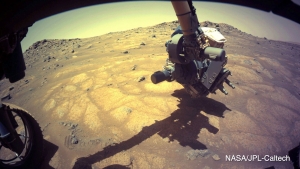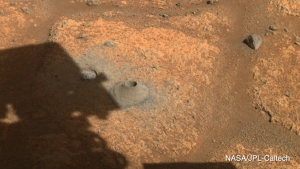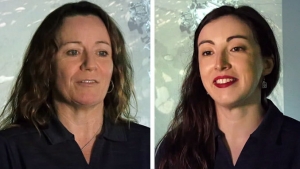University of Hawaiʻi at Mānoa scientists are currently exploring Mars via a car-sized robot known as the Mars 2020 Perseverance rover. Perseverance is the most sophisticated rover NASA has ever sent to the Red Planet, and the Mars 2020 team are helping acquire samples of rocks from its landing site, the floor of Jezero Crater, for return to Earth by a future mission.
After collecting samples and characterizing the lithology (the types of rocks) of the crater’s floor, Perseverance will head West to investigate the deposits of an ancient river delta, which formed early in Mars’ history when the crater contained a lake.

“When we’ve finished in this particular area, we’re going to head over to the delta front,” said Sarah Fagents, a researcher at UH Mānoa’s Hawaiʻi Institute of Geophysics and Planetology (HIGP) and volcanologist with the Mastcam-Z camera team. “Those deposits were laid down in a lake environment, and they might be the location of some of the best potential biosignatures, which is the key driver of this mission, to seek out the signs of [ancient] life.”
- Related UH News story: UH scientists begin new chapter in Mars exploration, February 19, 2021
Returning a sample of a lava flow or ash deposit would allow researchers to date the sample and determine an age for those deposits, which in turn allows them to more accurately date other surfaces on Mars, through a technique known as crater chronology.
“If we can find a lava flow or an ash deposit in Jezero, we can sample that deposit and bring back a sample to Earth in the future. And in our labs on Earth, we can date radiometrically (test) those samples and get an absolute age constraint on the deposits of Jezero Crater,” said Fagents.
Driving on Mars

The team has been using a newly enhanced auto navigation system, which allows the rover to drive on its own. Auto navigation makes 3D maps of the terrain ahead, identifies hazards and plans a route around any obstacles without additional direction from controllers back on Earth.
Using auto navigation allows the rover to drive longer distances in a day so the team can explore more of the terrain and acquire samples of diverse rock types.
“The auto navigation on the rover means that we can drive farther in a single sol, which is a martian day, which is really useful for this mission because we’re on a tight schedule to explore as much of the crater as we can,” said Eleni Ravanis, a HIGP PhD student and also a member of the Mastcam-Z team.
First 180 martian sols

After landing on Mars in February, the first 100 Martian sols were devoted to instrument checkouts, helicopter operations and initial science observations. The rover traveled short distances to test drive and instrument capabilities, drop off shields and covers, and deploy the helicopter for its historic flights. Since then, researchers have been working on their first science campaign devoted to acquiring samples, characterizing rocks and investigating the crater floor deposits.
“It’s so exciting to be able to see, for the first time, places that we’ve only seen from orbit before. So these are places that we’ve never seen close up, no one has seen close up before,” said Ravanis. “So it’s always really exciting to get these images back and share it with the team.”
UH cutting-edge research
This mission is the first stage of an international, multi-agency, decade-plus long program to bring samples from Mars back to Earth. Involvement in missions like Mars 2020 enhances the reputation of UH as an R1 research university, which continues to conduct cutting-edge research at the forefront of space exploration.
Work on the Mars 2020 mission contributes to the broader range of exciting research and educational initiatives in Earth, planetary and space sciences at UH. Research directly benefits the education of undergraduate students, providing programs such as HIGP’s Earth and Planetary Exploration Technology undergraduate certificate, and the College of Engineering’s aerospace engineering program, which are taught by faculty with experience in instrument design, active missions and analysis of Earth and planetary data sets.
These programs are training the future workforce in Hawaiʻi’s growing aerospace industry, and equipping students with the skills needed to address key problems faced by the state and nation.
This work is an example of UH Mānoa’s goal of Excellence in Research: Advancing the Research and Creative Work Enterprise (PDF), one of four goals identified in the 2015–25 Strategic Plan (PDF), updated in December 2020.


